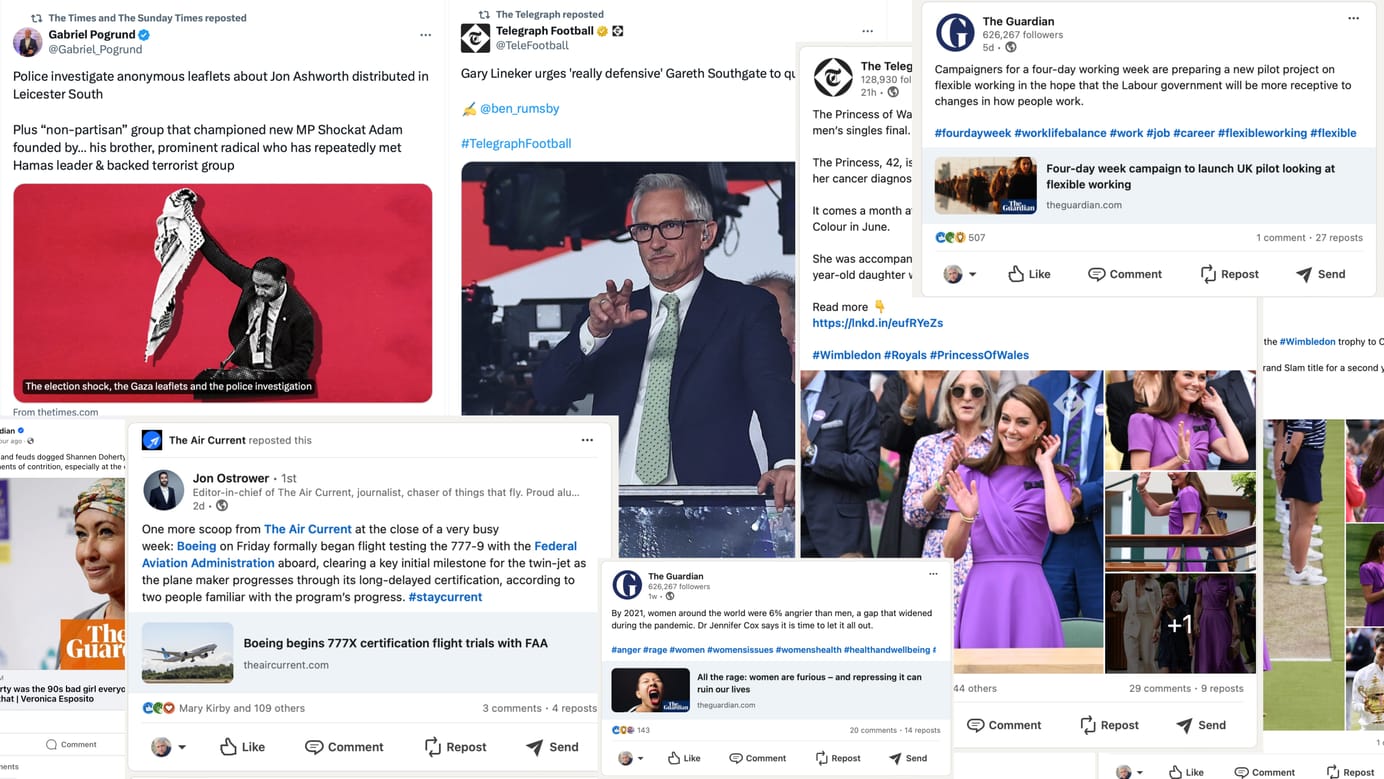
Journalism’s polycrisis, explained
While the waters of digital journalism have never been calm, right now we're passing through a storm that will sink some publications — but be the making of others. Here's what's causing that tempest.
I’ve been spending what little spare time I’ve had over the last couple of weeks thinking through the disruptive forces lashing journalism right now. It feels like the most turbulent period since the mid-2000s, when I started working in digital journalism development and the field we now call “audience”, but back then we called “community”. Then, we were beginning to realise that digital was the future, and we were learning to cope with the rise of blogs and Web 2.0, and its eventual shift into social media.
And now we're going through a similar period of disruption. I’ll be honest with you: I’m excited. These periods of profound shift, when established norms stutter and fail under societal and technological pressure, are a heady mix of danger and opportunity. When the wheel turns, some businesses get crushed, and some ride up to new prominence.
To help myself, my students and you lovely lot, I’ve been working to isolate the key threads, and this is how I’ve broken it down. See what you think.
The major forces impacting journalism in 2023
These are the six major trends I see. And don't worry: none of them are Web3, the Metaverse or AR. We've got bigger things to worry about first.
The slow decline of the existing social platforms.
Facebook’s cultural dominance is waning. Twitter is imploding in slow motion. Instagram remains strong, but isn’t growing and has never been a good source of traffic. TikTok is growing, but is politically, uh, complicated. Currently, it looks like the existing landscape of a few major players will be replaced by a more fragmented social network landscape. That’s going to require a whole new set of skills to navigate as reporters, editors, and publishers. But there’s also massive potential in the fragmentation, too, because we could well find a role as hosts of the communities we care most about.
Search is changing rapidly
While many publishers are still plugging away with keyword-based SEO models, Google has been rewiring the whole of search using machine learning behind the scenes to deliver intent-based search instead. Now, that ML tech is coming to the front of the search experience, with chat-based interfaces in testing at Google, and in use for Bing. These changes are unlikely to lead to more search traffic to publishers, so that means smart publishers need to fight for their share of a declining resource.
It’s not time to resort to dirty, black-hat and reader-hostile tricks. Many publishers are still recovering from the hit they took through the Helpful Content update because they went down that path. So, we need to be agile in our SEO approach, with a laser-sharp focus on searcher needs, not “keywords”. We have to prepare for some turbulence, and we need to really focus on converting search visitors into other forms of relationship, like newsletters and podcasts.
Search won’t die. And I don’t think generative search will kill traffic to websites. There’s a lot of work to be done in figuring out what generative AI is good at, and what humans are better at — and how to put the best human content in front of potential audiences.

Competition is on the upswing again
Back in the 2000s, the early blogs offered competition for attention to the traditional media. However, there was no easy route to monetisation for many of those sites, and the best bloggers were eventually absorbed into traditional media. YouTube paved the way for a new breed of publisher to rise, by providing easy monetisation of video. We still haven’t, as an industry, really got to grips with that, and it’s led to the devastation of things like the gaming journalism market, as the YouTubers win away so much of the attention. A whole new form of media exists in video, utterly detached from the mainstream of journalism.
We have, so far, avoided making the same mistake with podcasting. But now the newsletter platforms have done the same for the individual or small group text publishers that YouTube did for the video star: make it much easier to monetise an audience. Every penny spent on a Substack newsletter is a penny that potentially doesn’t go to traditional media. But it’s also a penny helping build the media businesses of the future.
Generative AI will change the balance of content
It’s a truism that the internet made attention scarce by making content abundant. Now Generative AI offers the potential to make the attention crisis infinitely worse, by creating a tidal wave of crap content that will be easy for even the best publisher to get lost in. In the long term, publishers who use AI to do better content will thrive. But first, they have to survive the attention apocalypse that AI could unleash.
I suspect that publishers that go all in on producing big volumes of AI content will quickly come to regret it: they’ll be looked back on with the same disdain we have for the content farms of the early 2010s. But there’s an emerging opportunity for clever deployment of machine learning to unlock our archives and help readers make the most of our existing content.
Volume business models are failing
The collapse of Vice and Buzzfeed’s exit from news are emphasising that the market for “attention trawlers” is not as big as many hoped. The business of producing massive volumes of content as cheaply as possible is a tough one to survive in. MailOnline is beginning to look like the winner in that space because who wants to make the investment and the compromises it would take to challenge them?
Just as the main social platforms are fragmenting, new media and supporting business models are likely to grow in the niches, as the big newspapers did back in the day. The journalism pundits won’t get excited because they like to pontificate about the big businesses —cough Semafor cough — but the interesting stuff is happening in small companies catering to tight niches.
The big businesses that will survive will be the ones that understand themselves as umbrellas sheltering a range of niche communities beneath them.

New skills are necessary, but still rare
One reason I’ve studiously avoided getting pigeonholed as an “SEO expert”, “analytics guy” or a “social media guru” is because I’ve always seen these as essentially sub-skills to a broader area of expertise: digital audience work. While, in the short term, at least, my bank balance might regret that choice, I suspect it’s far more sustainable as a career. The true skill is figuring out how to connect with audiences in the right way, based on their behaviours and their need for journalism. But you have to do that with an awareness of the business model needed to sustain it.
That’s a multidisciplinary approach, and it’s the one we now call “audience”. As more business are supported by direct reader contributions, through a combination of donations, memberships and events, this is a crucial skill set for the future of journalism. Yet, go to any head of audience, and ask them how hard it is to recruit people with the right skills. Yeah, that’s an issue.
The collapse of the big social platforms demands more sophisticated social skills. The search volatility demands more experimental approached to getting traffic. And any good audience team needs to be continuously experimenting, and watching what’s happening outside journalism, so they can learn from it.
Where are we going to find the people to do that?
Quickies
Playing catch-up on this, as I have a couple of weeks of open tabs to get through…
- 🏴 A historic newspaper archive in Scotland has been saved, after an appeal raised over £115,000 over six months. This is good. Archives are important.
- 🤖 Those of us outside the US can’t try the experimental AI version of Google Search — but here are some impressions from someone with access.
- 🐘 Ivory, a great Mastodon app for iOS, is now available on the Mac.
- 🎧 YouTube is getting more serious about becoming a podcasting destination. They’re planning on adding RSS ingestion, to directly import existing podcasts.
- 🇪🇺 Google Bard hasn’t rolled out in the EU. Guess why.
Digital Consequences
This article on the first children who have grown up with online parents feels incredibly timely after ur-blogger Dooce took her own life a few weeks back:
Barrett says she’s still feeling the effects of her mother’s decade of oversharing. When Barrett was 12, she says she was once followed home by a man who she believes recognized her from the internet. She was later bullied by classmates who latched on to all the intimate details of her life that her mother had posted online, and she ultimately dropped out of high school.
She and her mom have no relationship now, in large part because of the wedge her mother’s social-media habits put between them. Even with other people, Barrett says, she’s extremely private and can be paranoid about interacting. “I get afraid to even tell my friends or my fiancé something, because in the back of my mind I’m constantly like, Is this gonna be weaponized against me on the internet?”
Sign up for e-mail updates
Join the newsletter to receive the latest posts in your inbox.










